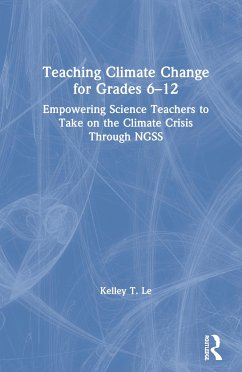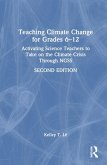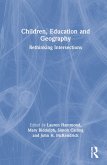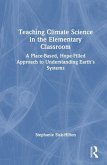Kelley T Lê
Teaching Climate Change for Grades 6-12
Empowering Science Teachers to Take on the Climate Crisis Through Ngss
Kelley T Lê
Teaching Climate Change for Grades 6-12
Empowering Science Teachers to Take on the Climate Crisis Through Ngss
- Gebundenes Buch
- Merkliste
- Auf die Merkliste
- Bewerten Bewerten
- Teilen
- Produkt teilen
- Produkterinnerung
- Produkterinnerung
Looking to tackle climate change and climate science in your classroom? This timely and insightful book supports and enables secondary science teachers to develop effective curricula ready to meet the Next Generation Science Standards (NGSS) by grounding their instruction on the climate crisis.
Andere Kunden interessierten sich auch für
![Teaching Climate Change for Grades 6-12 Teaching Climate Change for Grades 6-12]() Kelley T LêTeaching Climate Change for Grades 6-12198,99 €
Kelley T LêTeaching Climate Change for Grades 6-12198,99 €![Children, Education and Geography Children, Education and Geography]() Children, Education and Geography174,99 €
Children, Education and Geography174,99 €![Teaching Climate Science in the Elementary Classroom Teaching Climate Science in the Elementary Classroom]() Stephanie Sisk-HiltonTeaching Climate Science in the Elementary Classroom176,99 €
Stephanie Sisk-HiltonTeaching Climate Science in the Elementary Classroom176,99 €![Mobile Learning in Schools Mobile Learning in Schools]() Jocelyn WishartMobile Learning in Schools197,99 €
Jocelyn WishartMobile Learning in Schools197,99 €![Teaching Writing in the Age of Catastrophic Climate Change Teaching Writing in the Age of Catastrophic Climate Change]() Teaching Writing in the Age of Catastrophic Climate Change132,99 €
Teaching Writing in the Age of Catastrophic Climate Change132,99 €![Teaching Literature in Times of Crisis Teaching Literature in Times of Crisis]() Sofia AhlbergTeaching Literature in Times of Crisis182,99 €
Sofia AhlbergTeaching Literature in Times of Crisis182,99 €![Flower Breeding and Genetics Flower Breeding and Genetics]() Neil O. Anderson (ed.)Flower Breeding and Genetics242,99 €
Neil O. Anderson (ed.)Flower Breeding and Genetics242,99 €-
-
-
Looking to tackle climate change and climate science in your classroom? This timely and insightful book supports and enables secondary science teachers to develop effective curricula ready to meet the Next Generation Science Standards (NGSS) by grounding their instruction on the climate crisis.
Hinweis: Dieser Artikel kann nur an eine deutsche Lieferadresse ausgeliefert werden.
Hinweis: Dieser Artikel kann nur an eine deutsche Lieferadresse ausgeliefert werden.
Produktdetails
- Produktdetails
- Verlag: Taylor & Francis
- Seitenzahl: 222
- Erscheinungstermin: 21. Juni 2021
- Englisch
- Abmessung: 229mm x 152mm x 14mm
- Gewicht: 467g
- ISBN-13: 9780367752354
- ISBN-10: 0367752352
- Artikelnr.: 69935769
- Herstellerkennzeichnung
- Libri GmbH
- Europaallee 1
- 36244 Bad Hersfeld
- gpsr@libri.de
- Verlag: Taylor & Francis
- Seitenzahl: 222
- Erscheinungstermin: 21. Juni 2021
- Englisch
- Abmessung: 229mm x 152mm x 14mm
- Gewicht: 467g
- ISBN-13: 9780367752354
- ISBN-10: 0367752352
- Artikelnr.: 69935769
- Herstellerkennzeichnung
- Libri GmbH
- Europaallee 1
- 36244 Bad Hersfeld
- gpsr@libri.de
Kelley T. Le, Ed.D., is currently the Director of the Science Project at UC Irvine, where she supports K-12 teachers, educational leaders, and school districts with science, engineering, and equity for justice-centered education.
Introduction
A Pulse on the Current Climate
A Moment to Reflect
Beginning Where You Are
Shared Leadership
Purpose
Overview of Chapters
Learning Icons
Trust the Process PART 1: LOOKING BACK TO MOVE FORWARD Chapter 1: Reenvisioning Science Teaching
A Story About Tradition
An Opportunity to Challenge Science Education
Unveiling Your Teacher Disposition
Who Said, "The Scientific Method?"
Diving Deeper Into the Process of Science
Getting Cozy With the Nature of Science
Equity & Antiracist Science Teaching
Putting the Pieces Together Chapter 2: Leveraging the NGSS for Climate Change
A Story About Root-Bound Plants
A Second Look at the NGSS for Climate Science
A Fresh Take on the NGSS
The Role of Climate Literacy & NGSS
Climate Change as a Socioscientific Issue
Deeper Dive Into SSI
Moving Forward With Confidence PART 2: DEVELOPING SCIENTIFIC LITERACY USING CLIMATE SCIENCE Chapter 3: Climate Change is Complex, Where do I Start?
The Environmental & Climate Change Literacy Project Summit (ECCLPS)
Public Attitudes Regarding Climate Change
Identifying Your State of Mind
Climate Science Fundamentals
Earth's Energy Budget
Global Climate Change
Earth's Systems
Multiple Carbon Cycles
The Anthropocene
Scientific Consensus on Climate Change
Major Teaching Takeaways Chapter 4: Climate Change as the Anchor
Lessons About Bonsai Koi Fish
100Kin10 Predictions
Asking More Questions
Using SSI to Develop Scientific Literacy Skills
Taking More Back to the Class
Using Phenomena
Finding Phenomena
Anchoring Instruction on Climate Change Phenomena PART 3: PRACTICES THAT BUILD CAPACITY FOR STUDENT AGENCY Chapter 5: Planning & Teaching for Transformation
A Vision for Science Education
Overview of Storyline Design Components
Student-Driven Instruction
Launching Lessons With Phenomena
Intentional Discourse Opportunities
Developing Critical Thinkers in a Digital Age
Bringing it Back Chapter 6: Education for Climate Action
Tips on Talking About Climate Change
Big Problems Require Big Solutions
Climate & Social Justice
Resources that Build Student Capacity
Gauging Student Progress
Interactive Tools to Enhance Instruction
Empowering Students to Take Action
Concluding Remarks
A Pulse on the Current Climate
A Moment to Reflect
Beginning Where You Are
Shared Leadership
Purpose
Overview of Chapters
Learning Icons
Trust the Process PART 1: LOOKING BACK TO MOVE FORWARD Chapter 1: Reenvisioning Science Teaching
A Story About Tradition
An Opportunity to Challenge Science Education
Unveiling Your Teacher Disposition
Who Said, "The Scientific Method?"
Diving Deeper Into the Process of Science
Getting Cozy With the Nature of Science
Equity & Antiracist Science Teaching
Putting the Pieces Together Chapter 2: Leveraging the NGSS for Climate Change
A Story About Root-Bound Plants
A Second Look at the NGSS for Climate Science
A Fresh Take on the NGSS
The Role of Climate Literacy & NGSS
Climate Change as a Socioscientific Issue
Deeper Dive Into SSI
Moving Forward With Confidence PART 2: DEVELOPING SCIENTIFIC LITERACY USING CLIMATE SCIENCE Chapter 3: Climate Change is Complex, Where do I Start?
The Environmental & Climate Change Literacy Project Summit (ECCLPS)
Public Attitudes Regarding Climate Change
Identifying Your State of Mind
Climate Science Fundamentals
Earth's Energy Budget
Global Climate Change
Earth's Systems
Multiple Carbon Cycles
The Anthropocene
Scientific Consensus on Climate Change
Major Teaching Takeaways Chapter 4: Climate Change as the Anchor
Lessons About Bonsai Koi Fish
100Kin10 Predictions
Asking More Questions
Using SSI to Develop Scientific Literacy Skills
Taking More Back to the Class
Using Phenomena
Finding Phenomena
Anchoring Instruction on Climate Change Phenomena PART 3: PRACTICES THAT BUILD CAPACITY FOR STUDENT AGENCY Chapter 5: Planning & Teaching for Transformation
A Vision for Science Education
Overview of Storyline Design Components
Student-Driven Instruction
Launching Lessons With Phenomena
Intentional Discourse Opportunities
Developing Critical Thinkers in a Digital Age
Bringing it Back Chapter 6: Education for Climate Action
Tips on Talking About Climate Change
Big Problems Require Big Solutions
Climate & Social Justice
Resources that Build Student Capacity
Gauging Student Progress
Interactive Tools to Enhance Instruction
Empowering Students to Take Action
Concluding Remarks
Introduction
A Pulse on the Current Climate
A Moment to Reflect
Beginning Where You Are
Shared Leadership
Purpose
Overview of Chapters
Learning Icons
Trust the Process PART 1: LOOKING BACK TO MOVE FORWARD Chapter 1: Reenvisioning Science Teaching
A Story About Tradition
An Opportunity to Challenge Science Education
Unveiling Your Teacher Disposition
Who Said, "The Scientific Method?"
Diving Deeper Into the Process of Science
Getting Cozy With the Nature of Science
Equity & Antiracist Science Teaching
Putting the Pieces Together Chapter 2: Leveraging the NGSS for Climate Change
A Story About Root-Bound Plants
A Second Look at the NGSS for Climate Science
A Fresh Take on the NGSS
The Role of Climate Literacy & NGSS
Climate Change as a Socioscientific Issue
Deeper Dive Into SSI
Moving Forward With Confidence PART 2: DEVELOPING SCIENTIFIC LITERACY USING CLIMATE SCIENCE Chapter 3: Climate Change is Complex, Where do I Start?
The Environmental & Climate Change Literacy Project Summit (ECCLPS)
Public Attitudes Regarding Climate Change
Identifying Your State of Mind
Climate Science Fundamentals
Earth's Energy Budget
Global Climate Change
Earth's Systems
Multiple Carbon Cycles
The Anthropocene
Scientific Consensus on Climate Change
Major Teaching Takeaways Chapter 4: Climate Change as the Anchor
Lessons About Bonsai Koi Fish
100Kin10 Predictions
Asking More Questions
Using SSI to Develop Scientific Literacy Skills
Taking More Back to the Class
Using Phenomena
Finding Phenomena
Anchoring Instruction on Climate Change Phenomena PART 3: PRACTICES THAT BUILD CAPACITY FOR STUDENT AGENCY Chapter 5: Planning & Teaching for Transformation
A Vision for Science Education
Overview of Storyline Design Components
Student-Driven Instruction
Launching Lessons With Phenomena
Intentional Discourse Opportunities
Developing Critical Thinkers in a Digital Age
Bringing it Back Chapter 6: Education for Climate Action
Tips on Talking About Climate Change
Big Problems Require Big Solutions
Climate & Social Justice
Resources that Build Student Capacity
Gauging Student Progress
Interactive Tools to Enhance Instruction
Empowering Students to Take Action
Concluding Remarks
A Pulse on the Current Climate
A Moment to Reflect
Beginning Where You Are
Shared Leadership
Purpose
Overview of Chapters
Learning Icons
Trust the Process PART 1: LOOKING BACK TO MOVE FORWARD Chapter 1: Reenvisioning Science Teaching
A Story About Tradition
An Opportunity to Challenge Science Education
Unveiling Your Teacher Disposition
Who Said, "The Scientific Method?"
Diving Deeper Into the Process of Science
Getting Cozy With the Nature of Science
Equity & Antiracist Science Teaching
Putting the Pieces Together Chapter 2: Leveraging the NGSS for Climate Change
A Story About Root-Bound Plants
A Second Look at the NGSS for Climate Science
A Fresh Take on the NGSS
The Role of Climate Literacy & NGSS
Climate Change as a Socioscientific Issue
Deeper Dive Into SSI
Moving Forward With Confidence PART 2: DEVELOPING SCIENTIFIC LITERACY USING CLIMATE SCIENCE Chapter 3: Climate Change is Complex, Where do I Start?
The Environmental & Climate Change Literacy Project Summit (ECCLPS)
Public Attitudes Regarding Climate Change
Identifying Your State of Mind
Climate Science Fundamentals
Earth's Energy Budget
Global Climate Change
Earth's Systems
Multiple Carbon Cycles
The Anthropocene
Scientific Consensus on Climate Change
Major Teaching Takeaways Chapter 4: Climate Change as the Anchor
Lessons About Bonsai Koi Fish
100Kin10 Predictions
Asking More Questions
Using SSI to Develop Scientific Literacy Skills
Taking More Back to the Class
Using Phenomena
Finding Phenomena
Anchoring Instruction on Climate Change Phenomena PART 3: PRACTICES THAT BUILD CAPACITY FOR STUDENT AGENCY Chapter 5: Planning & Teaching for Transformation
A Vision for Science Education
Overview of Storyline Design Components
Student-Driven Instruction
Launching Lessons With Phenomena
Intentional Discourse Opportunities
Developing Critical Thinkers in a Digital Age
Bringing it Back Chapter 6: Education for Climate Action
Tips on Talking About Climate Change
Big Problems Require Big Solutions
Climate & Social Justice
Resources that Build Student Capacity
Gauging Student Progress
Interactive Tools to Enhance Instruction
Empowering Students to Take Action
Concluding Remarks








